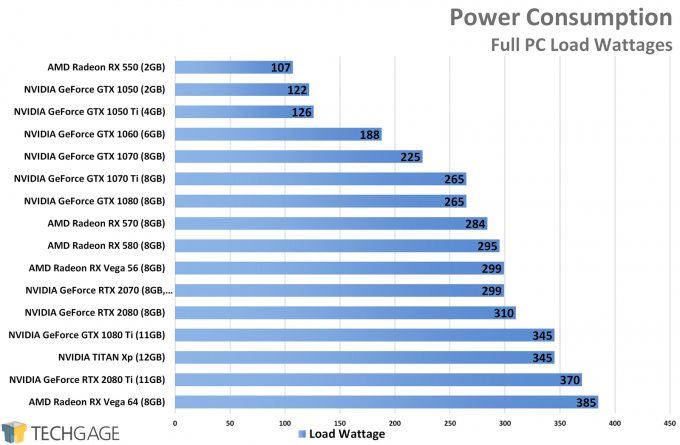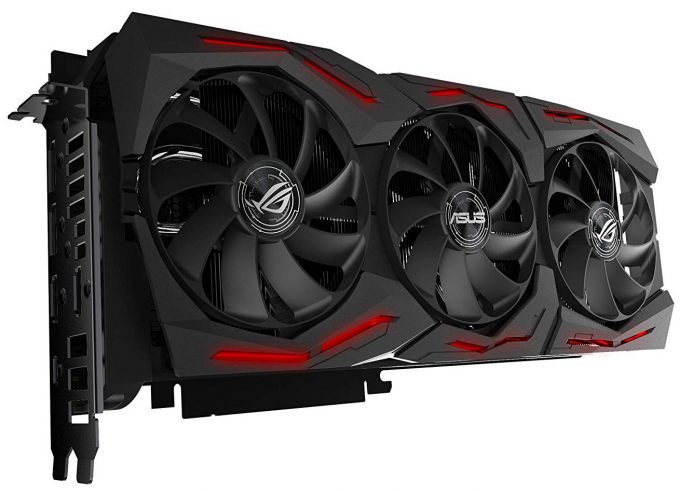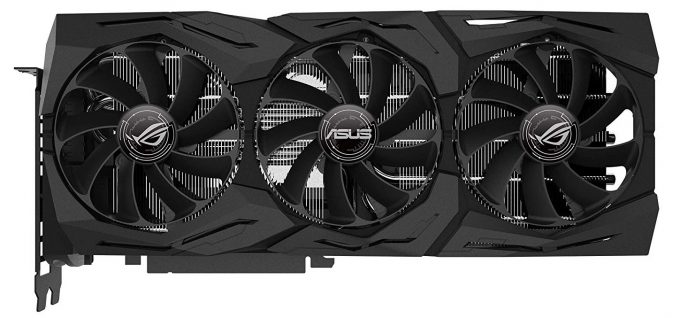- Qualcomm Launches Snapdragon 4 Gen 2 Mobile Platform
- AMD Launches Ryzen PRO 7000 Series Mobile & Desktop Platform
- Intel Launches Sleek Single-Slot Arc Pro A60 Workstation Graphics Card
- NVIDIA Announces Latest Ada Lovelace Additions: GeForce RTX 4060 Ti & RTX 4060
- Maxon Redshift With AMD Radeon GPU Rendering Support Now Available
NVIDIA GeForce RTX 2070 4K & Ultrawide Gaming Performance

NVIDIA’s third GeForce RTX card has landed, coming to us in the form of the $499 RTX 2070. In some regards, this card could be considered the most interesting of the three, as it’s not only powerful, it offers the least-expensive way to take advantage of RTX feature sets – ray tracing and DLSS. We’re taking a look at ASUS’ Republic of Gamers STRIX model, sporting three big fans and customizable RGBs.
Page 5 – Power Consumption & Final Thoughts
Power Consumption
The power consumption of the RTX 2070 seems to match the Vega 56, and sits 10W behind the faster RTX 2080. Overall, not too much to comment on here.
Final Thoughts
The GeForce RTX launch has been interesting, and perhaps a little strange. When the RTX 2080 Ti and 2080 hit the market, anyone who reviewed the cards had to offer the caveat that the special RTX features (DLSS, ray tracing) wouldn’t be available for launch. I doubt many at that time expected we’d be into November and still not have those features available to us.
NVIDIA was clear about the fact that the October update of Windows 10, with its DirectX DXR API, would be required to unlock full support of Turing’s RTX feature set. Well, that build of Windows 10 turned out to be a debacle in itself, with Microsoft having to pull it mere days after its release. Currently, it looks like the replacement build won’t drop until late this month.
What that ultimately means is that the wait to truly explore what RTX has to offer is going to have to wait. I haven’t heard many updates about RTX lately, and I assume it’s simply because NVIDIA has no idea when Microsoft will be able to get its part of the equation out the door. I still believe RTX is something worth being excited over. It’s just the wait that sucks.
When I found out NVIDIA wasn’t sampling the RTX 2070 itself, and was instead letting its partners handle the sampling, I had wondered why that might be. I am still not quite sure why, because the RTX 2070 is a great card at its asking price. Perhaps NVIDIA thought reviewers had too many Founders Editions in their labs, which would be fair for many of us.
On the topic of price, this ASUS STRIX commands about $100 more than the RTX 2070 suggested price of $500. I hate to admit at this point that I’m not sure if that premium is worth it, but like most of these things, it really depends on how much you weigh overclocking ability, and perhaps cooling ability. The STRIX includes a triple fan solution, which in my tests offered a lot of headroom..
In addition to boosted clocks (which might be attainable with manual overclocking on other cards), the ROG STRIX includes customizable RGBs, a dual BIOS, and again, the triple fan cooler that will probably improve upon the 2070 FE ever-so-slightly. But that’s just a guesstimate based on the fact that there are three fans here instead of the two on the RTX 2070. At the same time, ASUS’ STRIX is a beefy card, taking up just over 2 slots.
This review is far more abbreviated than I’d like. I’ve been focusing largely on workstation stuffs in recent weeks, and haven’t been able to dedicate as much time to gaming as I’ve wanted, and likewise haven’t been able to test out this card as thoroughly as I’d like. That’s why the title of this review references NVIDIA in general, and not ASUS’ card, because I have simply not been able to dig into its feature set properly yet, and thus feel I can’t do it justice.
That all said, general performance expectations of the RTX 2070 based on our testing can be seen in this table:
Game Performance Expectations |
|||||
| 1080p | 1440p | 3440×1440 | 4K | 144Hz | |
| RTX 2080 Ti | ★★★★★ | ★★★★★ | ★★★★ | ★★★★ | ★★★★ |
| RTX 2080 | ★★★★★ | ★★★★★ | ★★★★ | ★★★ | ★★★★ |
| TITAN Xp | ★★★★★ | ★★★★★ | ★★★★ | ★★★ | ★★★★ |
| GTX 1080 Ti | ★★★★★ | ★★★★★ | ★★★★ | ★★★ | ★★★★ |
| RTX 2070 | ★★★★★ | ★★★★★ | ★★★★ | ★★★ | ★★★ |
| GTX 1080 | ★★★★★ | ★★★★ | ★★★ | ★★ | ★★★ |
| RX Vega 64 | ★★★★★ | ★★★★ | ★★★ | ★★ | ★★★ |
| GTX 1070 Ti | ★★★★ | ★★★ | ★★ | ★ | ★★ |
| RX Vega 56 | ★★★★ | ★★★ | ★★ | ★ | ★★ |
| GTX 1070 | ★★★★ | ★★★ | ★★ | ★ | ★ |
| RX 580 | ★★★ | ★★ | ★ | ★ | ★ |
| GTX 1060 | ★★★ | ★★ | ★ | ★ | ★ |
| RX 570 | ★★★ | ★★ | ★ | ★ | ★ |
| GTX 1050 Ti | ★★ | ★ | ★ | ★ | ★ |
| RX 560 | ★★ | ★ | ★ | ★ | ★ |
| GTX 1050 | ★ | ★ | ★ | ★ | ★ |
| RX 550 | ★ | ★ | ★ | ★ | ★ |
| 144Hz values based on 1080p resolution with high detail goals. ★★★★★ 60 FPS? More like 100 FPS. As future-proofed as it can get. ★★★★ Surpass 60 FPS at high quality settings with ease. ★★★ Hit 60 FPS with high quality settings. ★★ Nothing too impressive; it gets the job done (60 FPS will require tweaking). ★ Not recommended. |
|||||
The ASUS STRIX model I tested here is pre-overclocked, which is unfortunate from the perspective that it’d be ideal to test “reference” clocks all-around. Sometimes, that’s impossible to avoid, but the fortunate thing is, NVIDIA’s Turing series is pretty overclockable, so you should be able to match or at least get awfully close to this card’s performance if you want to put in the effort to manually tweak the settings.
Ultimately, I’ll be visiting this card again soon, but since I’m overdue on an RTX 2070 look, I just wanted to get this live and revisit later when the time is right. If you have questions not covered in this article, about this GPU or life in general, please leave a comment below.
Support our efforts! With ad revenue at an all-time low for written websites, we're relying more than ever on reader support to help us continue putting so much effort into this type of content. You can support us by becoming a Patron, or by using our Amazon shopping affiliate links listed through our articles. Thanks for your support!








